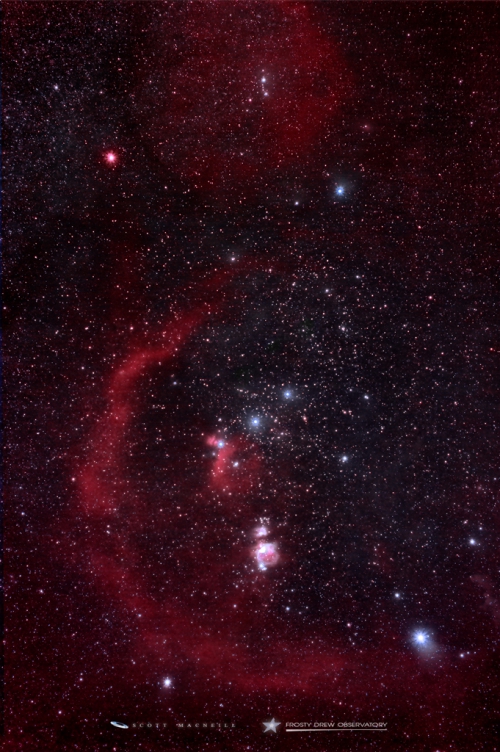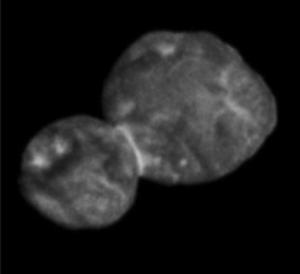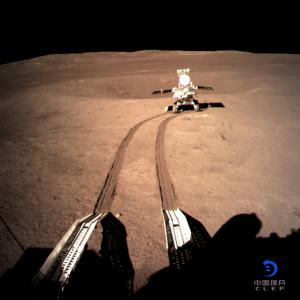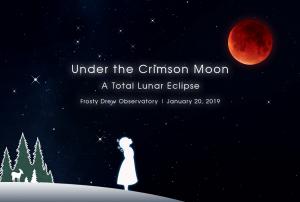
Stargazing Nights
- Where:
- Frosty Drew Observatory
- When:
- Friday January 4, 2019 at 7:00 p.m
- Cost:
- $5 Suggested Donation per person 5 years and older
Tonight is Stargazing Night at Frosty Drew Observatory, as well as the New Moon. Two things that go awesome together. Unfortunately, weather is not on board the wagon of awesome, with forecasts calling for increasing clouds later this evening, eventually becoming fully overcast with rain by morning. Though there is much variability in how heavy clouds will be this evening and how fast they will move in, which could give us a couple of hours to chase down clearings.
We will open the Observatory and Sky Theatre at 7:00 pm tonight. In the Observatory, telescopes will start on standby as we evaluate sky conditions on site. If acceptable, we will try for a view of the Orion Nebula, Sirius B (the white dwarf), and open star clusters. If clear enough, we will add to the list the Pleiades, the Andromeda Galaxy, the Perseus Double Cluster, and Comet 46P/Wirtanen - which has been fading a bit and is no longer visible to the unaided eye. In the Sky Theatre we will show our regular feature of celestial objects photographed at Frosty Drew Observatory and will offer a commentary if skies are completely overcast. We will stay open until 11:00 pm or until clouds chase us out, no earlier than 9:00 pm. Follow us on Twitter (@FrostyDrewOBSY) for updates on what we are viewing as well as a closing up post when we decide to pack up. If Twitter is not your gig, you can grab our latest posts on the right hand column of our website.
Overall, tonight’s forecast does not look too promising. We would normally consider it a no-go if it weren’t for the variability in forecasts for the first couple hours of our night. We could see enough clearings to catch a brief view of the cosmos, though clouds and rain will eventually set in. Add in that no Moon will be present tonight, and we think it’s worth a try. If making the long drive, you will want to sit this one out, it’s just too risky. Though if you’re in the local area and are looking for a much needed astro-fix, then stop in and battle the clouds with us.
------------------------
Weekly Happenings
Scott MacNeill
On New Year’s Day 2019, as we were all ringing in the New Year on the East Coast, the NASA New Horizons mission was zooming past Kuiper Belt Object (KBO) – 2014 MU69, commonly referred to as “Ultima Thule”, at over 32,000 miles per hour, at a distance of 2,200 miles. Ten hours later, at 10:29 am EST, we received the first post-flyby signal from New Horizons confirming optimal spacecraft health and an extensive data set collected during the flyby. The first images of MU69 started coming back later that day and continued until yesterday, January 3, 2019. For the next seven days, New Horizons will hold off on transmitting any new data as the spacecraft passes behind the Sun from our point of view, with data transmission resuming on January 10, 2019. Initial data analysis has revealed that MU69 is in fact a contact binary, which are two separate objects that have gently come into contact with each other in a way that both objects remained relatively intact, and remain connected. Additional findings indicate that MU69 has no significant moons or rings, though this can change as we receive new data, and no atmosphere appears to be present. Like the Pluto flyby that New Horizons completed in July 2015, it will take nearly two years for all data of the flyby to be received at Earth. Though the Mu69 flyby has completed, new images and discoveries will keep us hooked for the next 20 months. Check out this image of MU69 captured by New Horizons on New Year’s Day about a half an hour before closest approach. Take a moment to visit the New Horizons page, check out the fabulous images coming in, and catch up on all the amazing things this little spacecraft is doing as we gear up for a fabulous year in the Kuiper Belt!
On Wednesday night, January 2, 2019 at 9:26 pm EST, the Chinese National Space Administration (CNSA) successfully landed the Chang’e-4 spacecraft on the far side of the Moon. This is the first time any spacecraft has attempted to land on the the far side of the Moon. Being that the Moon is tidally locked to Earth, which means the Moon spins on its axis at the same rate that it orbits the Earth, we always see the same side of the Moon. The other side, which faces away from us, posses a few problems with landing. The largest problem is communications. Any spacecraft that lands on the far side of the Moon will not be able to communicate with Earth, which is on the other side of the Moon (no line of sight). To solve this problem CNSA launched a communications satellite in May, 2018, which assumed a position at Lagrange Point 2 (L2), which is a spot of gravitational balance that resides about 40,000 miles passed the Moon, when viewed from Earth. At the L2 location, the combined gravity of the Moon and Earth will balance out the centrifugal force of a third party object, like a satellite. This allows for a satellite to maintain a natural gravitational balance with the Earth and Moon. Additionally, at this distance beyond the Moon, communications with Earth and the far side of the Moon become possible via relay. Chang’e-4 touched down in the Von Karman Crater, which resides at the South Pole Aiken basin, one of the largest impact craters in the Solar System. After touchdown, Chang’e-4 deployed the Yutu-2 rover to the surface of the Moon. Some of the mission highlights include tracking the growth and development of potato plants, and silkworms on the lunar surface, as well as conducting radio astronomy from the rather quiet radio environment that the far side of the Moon has. Check out this image of the Yutu 2 rover on the lunar surface, then send a high five to China for putting humanity on the far side of the Moon!
Save the Date:
A Total Lunar Eclipse is coming to the United States on Sunday, January 20, 2019 and Frosty Drew Observatory will open to celebrate this fabulous event. Our festivities start at 8:30 pm and go until 3:00 am Monday morning. Being that Monday, January 21, 2019 is Dr. Martin Luther King Jr. Day, this is a fabulous night to drag out the kids for some science. We will have telescopes setup in the Observatory courtyard showing the Moon as the eclipse progresses as well as a live projection of the Moon on screens inside the Sky Theatre, and inside the Observatory, not to mention some of the best skies in Southern New England. During the total eclipse period, the winter Milky Way will shine alongside the crimson Moon, a fabulous sight to see. So put a little science on your calendar and make plans now to geek out with a fabulous Total Lunar Eclipse in just over two weeks time.
-Scott



